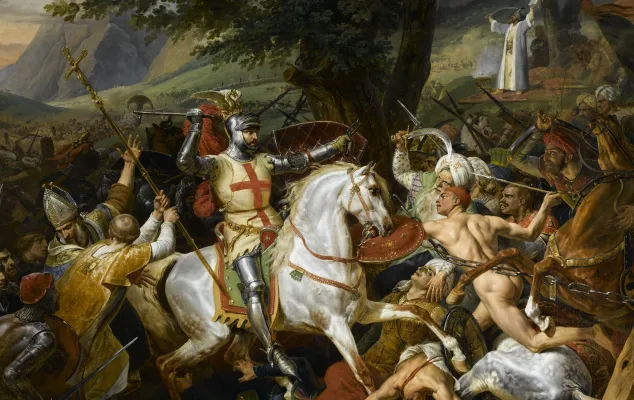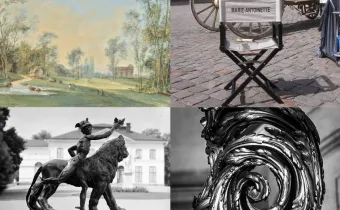Masterpieces of the King’s Chamber, the echo of Caravaggio at Versailles
From March 14 to July 16, 2023
Madame de Maintenon’s Apartment
One of the most popular rooms in the Palace of Versailles, the King’s Chamber is better known for its symbolism than for the masterpieces it holds. The aim of this exhibition is to give the paintings that adorn these chambers the attention they deserve by admiring them for the first time at eye level.
In 1701, Louis XIV decided to transform the salon in line with his small apartment, which opened onto the Hall of Mirrors, into a state room, making this space the epicentre of court life. The king monitored the modifications to the room closely and chose to keep five of Valentin de Boulogne’s paintings and four medallions whose attributions have varied over time. However, due to the creation of the gilded stucco relief above the bed, three paintings by Giovanni Lanfranco, Nicolas Tournier and Valentin de Boulogne were removed from the woodwork.
The modifications made in transforming the salon into a state room demonstrate the monarch’s taste for Caravaggesque painting. The paintings are of sober composition and virtuoso touch, playing with the density of the shadows to better contrast with the sumptuous decor of the room, highlighted with gold. In the royal bedchamber, the king chose to feature religious subjects that emphasized the Christian piety of his final years, as well as French painter Valentin de Boulogne. The artist, born in 1591 and shown in Rome as of 1614, drew the power of his palette from the models that Caravaggio had left in the Eternal City and the low-life characters he frequented in Rome until his death in 1632.
The Palace of Versailles is bringing together for the first time all nine of the canvases that hung in the salon, in addition to the medallions, thanks to exceptional loans from the Louvre and the Tessé Museum in Le Mans.
Commission : Béatrice Sarrazin, General Curator of Heritage at the National Museum of the Palaces of Versailles and Trianon
Noël Coypel, painter of monumental works
From September 26, 2023 to January 28, 2024
The Queen’s Guard Room and Grand Trianon
Versailles is synonymous with large sculpted, gilded and painted decorations, of which Noël Coypel was one of the outstanding creators in the 17th century. Thus, nowhere could be more appropriate than the Palace of Versailles to evoke these large ensembles, which are highlights of this now all but forgotten artist’s work, whose career nevertheless flourished under the wealth of power.
Founder of a dynasty of painters, Noël Coypel (1628 - 1707) won renown in several areas: ceiling and easel paintings, graphic arts, and tapestry cartoons. After his initial training in Orléans, he returned to Paris and participated in designing the opera sets for Luigi Rossi’s Orfeo. He impressed painter Charles Errard, director of the Louvre’s royal decorations at the time, hence monumental décors became his primary occupation: first the Parliament of Rennes, then the royal residences and finally, at the twilight of his life, the Invalides. Some of these works have now disappeared – in the Louvre, Fontainebleau, Palais Royal, and even those of the first Versailles – while others are known only through a few paintings, which will be presented at the exhibition.
At the same time, Noël Coypel met with brilliant success at each stage of his academic career. He entered the Royal Academy of Painting and Sculpture in 1663, and was appointed professor in 1664 before becoming head of the French Academy in Rome from 1673 to 1675, then head of the Royal Academy of Painting and Sculpture in 1695.
This first exhibition dedicated to Noël Coypel will honour the artist through a selection of 90 works (paintings, drawings, tapestry cartoons, etc.) presented in the Grand Trianon and at the palace in the Queen’s Guard Room, under a décor he created himself and which underwent restoration between 2015 and 2017. As an extension of this exhibition, the Rennes Museum of Fine Arts will organize an exhibition covering the painter’s entire career in 2024.
Commission: Béatrice Sarrazin, General Curator of Heritage at the National Museum of the Palaces of Versailles and Trianon, and Guillaume Kazerouni, in charge of historic collections at the Museum of Fine Arts of Rennes
Horace Vernet
From November 14, 2023 to March 17, 2024
The Africa and Crimea Rooms
In November 2023, the Palace of Versailles is dedicating a major retrospective to the painter Horace Vernet (1789 - 1863). Closely linked to the Versailles of Louis-Philippe, for over thirteen years the artist produced some of the most beautiful paintings in the historic Galleries. Today, Versailles houses the largest collection of his works. More than forty years after the last exhibition dedicated to Vernet, this retrospective of some 200 works provides an opportunity to discover many heretofore unexhibited masterpieces, accompanied by sketches and drawings demonstrating the artist’s methodology.
Born in 1789 in the Louvre, Horace Vernet is the grandson of Joseph Vernet, a seascape painter, and the son of Carle Vernet, an equestrian painter. A worthy heir to the family dynasty, not having obtained the Prix de Rome he won the favour of Napoleon I and his family very early on.
First evolving within the Romantic art circle of the 1820s alongside his friend Théodore Géricault, Vernet developed an easy and seductive style before discovering lithography. He became the favourite painter of the Duke of Orléans, the future Louis-Philippe.
At the Salon of 1822, Horace Vernet saw his paintings refused. He then organised a personal exhibition in his studio, the immense success of which definitively established his reputation. It was the start of a long official career. This exhibition will endeavour to show the stylistic evolution of Horace Vernet’s works, moving from the Romantic passion he shares with Géricault to more measured scenes of battles.
The exhibition will highlight the importance of Horace Vernet’s travels, particularly in Italy and Algeria. Appointed director of the French Academy in Rome in 1829, Horace Vernet discovered the great classical Italian models and tried his hand at history painting. In 1833, he discovered Algeria and concentrated on Orientalist painting, alternating civil, religious and military subjects. Two years later, he was commissioned to depict the military conquests of Louis-Philippe’s heirs in the Africa rooms of the Palace of Versailles. This period of major orders was punctuated by numerous trips to the East and to Russia. Under the Second Empire, his career was hailed with a retrospective of his work at the Exhibition Universelle of 1855. He died in 1863 after having received the medal of Grand Officer of the Legion of Honour.
A prolific painter, both acclaimed and derided by critics, Horace Vernet did not leave his contemporaries indifferent. This retrospective will underscore the painter’s ease of style and the richness of his preferred subjects. It will reveal his love for horses and hunting, his attachment to the Napoleonic epic and feats of arms, his taste for Romantic literature, Lord Byron or even the staging of his family origins. A talented painter, Horace Vernet distinguished himself in all genres, especially portraiture. The exhibition will showcase many of his paintings kept in private collections. Additionally, Vernet rapidly gained a degree of celebrity, which led him to pose for several colleagues. The exhibition will present some of these portraits by his contemporaries.
Retracing the entire career of the painter, this retrospective will dive into the 19th century of Horace Vernet. On this occasion, the canvases of the Africa Rooms will be visible.
Commission: Valérie Bajou, General Curator at the National Museum of the Palaces of Versailles and Trianon
Presentation of new acquisitions in the Pope’s Room
The Palace of Versailles regularly acquires works and objets d’art. In order to exhibit the newly acquired artworks, the Palace of Versailles has dedicated a museum area leading to the Pope’s Room.
A bust of François Girardon representing Georges Mareschal, Louis XIV’s first surgeon, was acquired in 2020. It will be on display until January 2023.
Additionally, an iconic painting by Hubert Robert, acquired through an exceptional patronage, several drawings recently acquired by the museum’s Graphic Arts Department and a portrait of Marie-Antoinette as a Dauphine by Duplessis, acquired thanks to the Société des Amis des Versailles, will be presented.
The Palace of Versailles’ acquisition policy
As a national museum, the mission of the Palace of Versailles is to contribute to the enrichment of public collections by acquiring cultural property on behalf of the State. Acquisitions, donations and bequests allow to bring new artworks and objets d’art that enlighten existing collections, complete their purposes and fill the gaps. The fields are very diverse and include an extraordinary collection of portraits that illustrates the «glories of France» and makes Versailles a French «National Portrait Gallery».
Furthermore, the Palace of Versailles has followed a proactive policy aimed at its refurnishing.
The research carried out by the Conservation Department regularly allows for the identification of Versailles. To the best of its ability, the Palace of Versailles positions itself with a view to acquiring these pieces and presenting them to the public in spaces whose condition bears the closet possible resemblance to that of the former royal residence.





